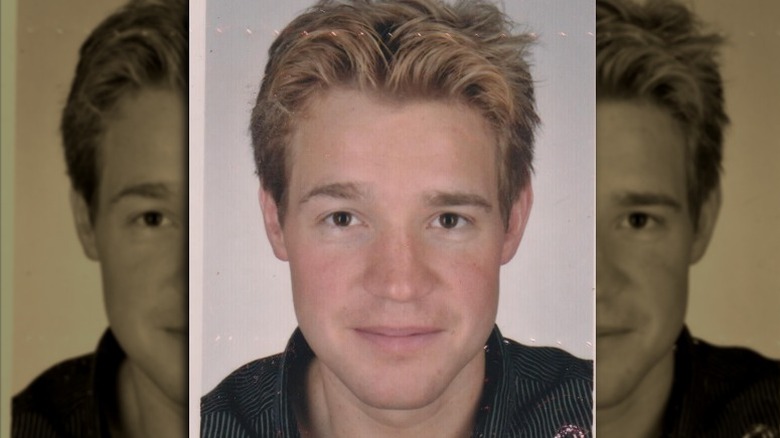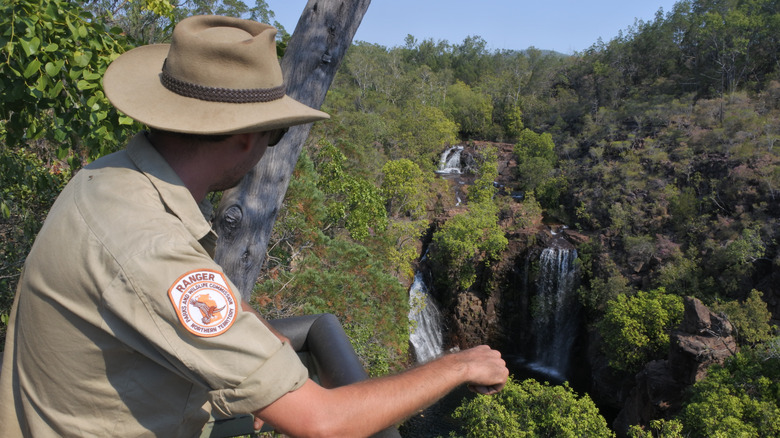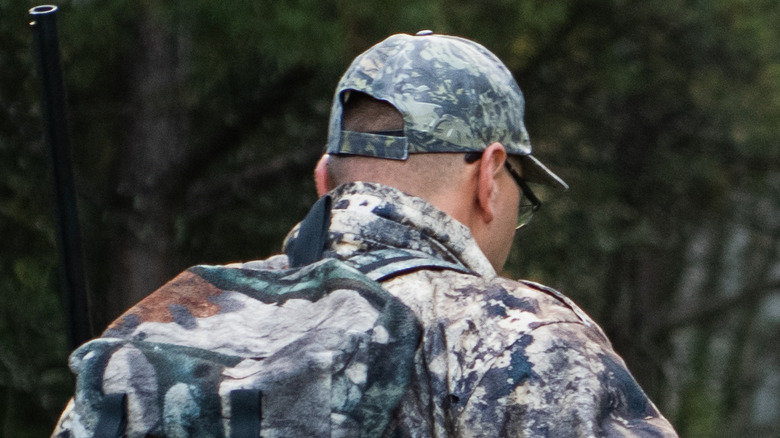Creepy Stories: These People Were Swallowed Alive By The Forest
Plenty of people have disappeared into forests over the years, never to be seen again, as is the case for the people covered blow. In all likelihood, some of them are dead, not necessarily due to slavering beasts or nefarious people but because some of these disappearances occurred some time ago.
However, that is not the case for all. Some of these people disappeared only a few years ago, and there's a chance that some have made it out of the woods. There's even a chance — albeit a slim one — that they have found this article. (Call your mother. She's sick with worry.)
Also, judging from the cases below, it would be irresponsible to say outright that there is something in the mountains in Washington that is gobbling up hikers, but if you're heading into the woods, make sure that others know exactly where you are going and when you plan to be back. And maybe bring a buddy to fend off whatever lurks in those mountains.
Lars Mittank
On July 8, 2014, 28-year-old German tourist Lars Mittank died the way he may have lived: after a fistfight about football teams. According to Culture Crossfire, he had been vacationing with friends at Bulgaria's Golden Sands. However, owing to a ruptured eardrum sustained during said fight, he couldn't fly. A doctor prescribed him Cefuroxime 500.
According to Mel Magazine, Mittank stayed the night in a cheap hotel in Bulgaria, close to the airport. He texted his mother that he did not feel safe, adding that he was hiding from four men. He returned to the doctor's office the following day but ran out, climbing over an 8-foot barbed-wire fence to escape into the forest. His last known moments were caught on security footage. Footage from the hotel showed him pacing in the foyer and hiding in the elevator. Even the doctor that morning stated that Mittank "was really nervous and erratic" and said, "I don't want to die here."
Mittank had also texted his mother asking, "What is Cefuroxime 500?" Even if the medication did not directly cause his issues, it might have escalated his paranoia. Internet investigators speculate that the blow to the head or the antibiotic may have caused Mittank to fall into psychosis. However, this is not any listed side effect of Cefuroxime, according to Mayo Clinic.
The Berlin Speculator reported that a truck driver might have given Mittank a ride in 2019, only to realize who he was after the fact. His mother Sandra theorizes that Lars somehow lost his memory in the forest.
Maureen Kelly
The New York Daily News reported that Maureen Kelly, 19, left her camp at the Canyon Creek Campground near Vancouver, Washington, on June 9, 2013. She told her friends that she was going on a "spiritual quest" into Gifford Pinchot National Forest, removing her shoes and all her clothing aside from a fanny pack containing a pocketknife, matches, and compass. Undersheriff Dave Cox told ABC News, "The folks that she was with, they felt that this [spiritual quest] was something she needed to do."
Her friends expected that she would return in a few hours. Cox noted that the terrain where Kelly was very steep, so she couldn't have gone too far. "It's going to be a tough go for her," he said, "especially with no shoes."
The search crew combed the area for any trace of her, but all they could find were footprints going to a paved road — not necessarily Kelly's. Though temperatures were in the mid-70s when she disappeared, they plummeted to 40 degrees soon after. According to The Charley Project, authorities assume that she died, but no trace of her has been found.
Terrence Woods Jr.
According to Deadline, TV production assistant Terrence Woods Jr. disappeared on October 5, 2018, while filming in Penman Mine, an abandoned gold mine in Idaho, for Discovery's "Gold Rush: Dave Turin's Lost Mine."
The morning he disappeared, Woods texted his father that he would be cutting his time on the shoot short by several weeks. In an email to Raw TV, for whom Woods had been working, he said that he needed to be with his mother owing to a health condition — something his mother said was not necessary. Woods had reportedly been having mental health issues. According to Vice, that evening, Woods said he needed to use the bathroom and then dropped his radio before running down a cliff into the forest. People ran after him but returned torn and bloodied from the rough terrain.
The formal search did not begin until the next morning and ended unsuccessfully six days later.
Woods' parents suspect that Raw may not be telling the whole truth. His father told Deadline, "You say my 97-pound son ran down the cliff without tripping, falling, hurting himself. You don't have a trace of his blood or piece of his clothing." Raw denied the accusation, defending that they did all they could during search-and-rescue. A spokesperson for Raw said, "In such a tragic case there will inevitably be speculation about his disappearance, which is neither helpful or fair to Terrence, his family or the crew who worked so hard to try and help."
Alfred Beilhartz
Alfred Beilhartz, who was four years old when he went missing, disappeared on July 3, 1938. According to Strange Outdoors, Beilhartz's family had been camping at Colorado's Rocky Mountain National Park, close to the Fall River Lodge. Beilhartz had followed his father to the stream to wash up, and then he went to family friends 500 feet upstream. Once everyone had returned to camp, they noticed Beilhartz had gone missing.
Given how little time had elapsed, they were sure Beilhartz could not have gotten far. Park rangers soon rallied 100 members of the Civilian Conservation Corps, but even the Bloodhounds they brought could not pick up Beilhartz's scent. According to The Charley Project, the rangers dammed the river in case he drowned but still turned up nothing. The search was called off after ten fruitless days.
A couple claimed to have seen Beilhartz atop a rocky outcrop called Devil's Nest, six miles and around 3,000 feet higher from where he had gone missing. The child made a "shrill noise" over the edge and then left or was pulled back. Another woman thought that she had seen him with an unknown man on the road.
The family received a ransom note demanding $500, but the police determined that this was a hoax — though they charged no one.
Paula Jean Welden
When Paula Jean Welden went missing on December 1, 1946, the 18-year-old Bennington College sophomore would not have been hard to recognize. According to the Bennington Banner, she wore a vivid red coat with a fur collar, along with jeans and sneakers that suggested that she did not intend her hike to be long.
A gas station owner reported a thin woman running through a gravel pit near the college. Next, a man picked up a young woman hitchhiking, dropping her off near the mouth of the Long Trail. The last sighting was a watchman, who warned her against hiking in such light clothing.
Classes at Bennington were suspended so that the students could help with the search. Welden's father called in police from New York and Connecticut — as Vermont lacked their own force. Suspicion fell on both her father, with whom she'd had a falling out, as well as supposed boyfriends. The Charley Project pointed out that Welden left behind money and an uncashed check from her parents. She was not running away.
In 1955, a lumberjack said that he had followed Welden into the woods and knew where she was buried. When questioned, however, he admitted that he was joking. In 1968, a skeleton was found in Adams, but it was too old to be Welden. According to Strange Outdoors, some suspect that Welden ran afoul of the Bennington Triangle, a place known for Bigfoot and UFO sightings.
Dennis Martin
Dennis Martin, then six, was on an annual Father's Day camping trip at Smoky Mountain National Park when he went missing in 1969, according to HowStuffWorks. Martin and his brothers had planned to jump out at the adults from different parts of the camp to scare them. They jumped out. Martin didn't.
Dark Tales described how the family, along with park rangers, hikers, and even U.S. Army Green Berets — 1,400 people in total — tried to find him. Given his red shirt, it should have been easy, but it also rained heavily that night, washing away potential clues. Even park ranger Dwight McCarter, who had tracked down hundreds of missing hikers, had to admit that Martin left no traces. However, all the people searching may have obscured Martin's tracks.
A nearby family reported that they had heard a scream the evening Martin went missing and saw a "bear-man" with something over its shoulder. However, this lead was not followed up. Mysterious Universe quoted a supposed retired Army SOCOM Commander saying of this search, "Our Special Forces are NEVER called to assist in civilian operations. ... The fact that they were armed as well is another huge no-no. ... Something is very wrong with this missing kid scenario."
A man informed authorities in 1985 that he had found a child's skeleton but did not tell anyone at the time because he had been illegally collecting ginseng and did not want to be prosecuted. When people went to check this lead, they found nothing.
Prabhdeep Srawn
Canadian army reservist Prabhdeep Srawn, 25, was about the last person one would expect to go missing, Australia's ABC News reported. His disappearance could be chalked up to a lack of preparedness, however.
When Srawn started on the Main Range trail near Mount Kosciuszko, he reportedly had only jeans and a light jumper. The weather was pleasant then but turned rapidly for the worse by that afternoon. From the low visibility caused by the snowfall alone, Srawn could have lost his way.
According to The Star, there was every indication that Srawn intended to return. The van he had rented was due to be turned in the following day, which was why someone noticed that he was missing. He had even left a laptop in it.
Eight days after Srawn went missing, two rangers claimed to have heard "human yells" coming from the area, but they found nothing. Coroner Harriet Grahame declared that Srawn died around May 14, 2013, but this is supposition. No evidence was ever found. Still, she pointed out that he had neither "a tent [nor a] snow sleeping bag" and hadn't bought much food before leaving on this hike. Srawn's family, however, held out hope that he could be alive, sending a statement ending with "miracles do happen."
Thelma Melton
For almost 20 years, Thelma Pauline Melton regularly hiked the Deep Creek Trail in the Smoky Mountains, where she went missing on September 25, 1981. Unsolved Appalachia states that she went there that fateful day with two friends and her husband Bob, who was 20 years older than Melton and not up for hiking. According to The Doe Network, Melton was overweight, had high blood pressure, and needed medication, so she was unlikely to stray far.
The Deep Creek Trail is listed as easy, so no terrain should have proven challenging for the 58-year-old. During the hike, Melton began walking faster, leaving her two friends behind. When they finished the same path and returned to the trailer 30 minutes later, Melton was not there. Within an hour and a half, she was reported missing. That week, more than 150 people and nine dogs searched the trail, but nothing turned up.
In the aftermath, Melton's pastor implied that she might have been having an affair but provided no evidence. There was also the suggestion that she might have harmed herself, but the evidence for this was scant. (Her mother died that year, and her husband's bottle of Valium was missing.) Before going for the hike, she had prepared spaghetti sauce for dinner that night, more than suggesting that she intended to return.
Paul Fugate
The person least likely to become lost in the woods — but with the most opportunity — is a park ranger. According to National Parks Traveler, Paul Fugate vanished on January 13, 1980, from his job at Chiricahua National Monument in Arizona. He told a coworker that he expected to be back by 4:30 p.m. but to start closing if he was not, and he left his radio and keys behind while he checked out the trails.
He was declared missing that night, and by January 15, a full search, including a National Guard helicopter, commenced. The only lead was from an acquaintance and his wife, who claimed to have seen Fugate in his uniform, unconscious between two men in a pickup truck. Other workers found signs of a fight and spinout tracks in a dirt road. In 1983, the Cochise County Sheriff's Office claimed that the arrest of "more than one person" for Fugate's murder was soon to occur. However, no one was ever charged.
The National Park Service initially began making partial salary payments to his wife but later fired Fugate in absentia and demanded the salary payments back, with 11% interest, assuming he abandoned his post. According to Strange Outdoors, vanishing was unlikely. Fugate left behind cash, valuable guns and camera equipment, and a truck he'd been restoring.
After 40 years, without disclosing why, the Park Service's Investigative Services Branch reopened their inquest into Fugate's disappearance. To this day, there is a $60,000 reward.
Shawn Higgins
Shawn Higgins knew the Siskiyou Mountains in Southwest Oregon well. He skipped school with his girlfriend at 15 to go turkey hunting there. Years later, his girlfriend Stephanie had become his wife, he had raised two sons, and the mountains were "a place for [his] family."
Shawn and Trevor, his 21-year-old son, had gone out hunting on October 14, 2016. They separated, but the plan was to meet at the truck later to pick up Trevor's uncle, who was hunting in a different part of the woods. Trevor waited by the road with a freshly killed buck, but his father never arrived. Trevor and his uncle looked for Shawn, to no avail. So that he would not get lost himself, Trevor built a shelter once night fell. Higgins hadn't brought his backpack with him, expecting that he would not be in the woods long. In the bag was a GPS, which would have allowed his family to find him.
Four days later, Trevor was found a few miles from where he had begun his own search. Stephanie found this bittersweet, KOBI 5 reported. She had hoped until then that Trevor was with his father. When medics airlifted Trevor, he was suffering from severe hypothermia. Hundreds of people took up the search for Shawn, but nothing was found. Not a scrap of cloth. Not bullets.
NBC News quoted Stephanie: "I know he didn't just get lost. Something happened to him."
Kurt Newton
According to New England Today, 4-year-old Kurt Newton caused "the most extensive woods search in the history of Maine." He vanished from the Natanis Point Campground in Manchester during a long Labor Day weekend in 1975.
Kurt was painfully shy and consistently clung to his mother. The idea that he would have gone off with someone else struck her as unfathomable. He was not an adventurous boy and would, for the most part, stay where his parents left him. Yet, she seems to have been wrong.
According to WCYY, since the weekend had been muddy, she went 50 yards from the campground to clean his shoes. He hopped onto his trike to catch up with his father, who had taken off in his Bronco to cut firewood. A quarter-mile from the campsite, a 12-year-old girl said she saw a small boy on a tricycle, but he would not answer her. The girl's father, a volunteer caretaker for the campground, found the tricycle next to a dump. He assumed it was discarded and threw it onto the trash heap.
There were only ten minutes between Newton leaving the campsite and his parents discovering his absence. The family frantically asked if anyone had seen a boy on a tricycle and then, when the man who threw out the trike told them, rushed to the dump, to no avail. They assumed that their son couldn't have run off willingly and had to have been kidnapped.
Samantha Sayers
Samantha Sayers left at 8 a.m. on August 1, 2018, for a solo hike in the North Cascades mountains in Washington. According to Strange Outdoors, she had expected to check in on her boyfriend by 6, since he had work and could not join her. By 8 p.m., he was at the trail, trying to track her down. At 1 a.m., her family reported her missing.
The Vesper Peak Trail is not meant for novices. Hikers have called the trail "hard to follow." However, Sayers was far from a newbie and had hiked there before.
The search for Sayers was one of the most intensive Snohomish County authorities had undertaken, involving 14 dog teams and helicopters with thermal imaging cameras, GoErie reported. Drones canvassed the area. Volunteer searchers left bags containing supplies, along with notes reading, "Stay Strong! We're looking for you. Everyone is thinking of you." Police interviewed witnesses who saw her ascend, but no one admitted to seeing her return. (As she was bald owing to alopecia, she was more noticeable.) She had lunch near the peak with an unknown man at around 3 p.m., but they went their separate ways afterward.
After three weeks, the official search was called off. Search and Rescue Sgt. John Adams said, "If there was a place we thought she could get to, we put people there to look for Sam, often putting our volunteers and personnel at great risk due to the rugged, remote, and dangerous terrain."
Chet Hanson
According to Strange Outdoors, Chet Hanson, 27, was a fan of photographing nature, which may have contributed to his disappearance on November 11, 1997, in Mt. Rainier National Park in Washington. He brought 35 pounds of camera equipment with him when he left around 6:30 a.m. on his hike and told his mother that he would be home for dinner. Still, when he didn't show up, she wasn't too concerned and assumed that he was staying with friends.
The Seattle Times stated that Hanson was only reported missing after he failed to come to work the next day. His car was found at the Deer Creek Trailhead. It was opened and contained negatives, a key ring, and papers — nothing that would provide a clue to his disappearance.
According to The Spokesman-Review, Hanson had not dressed to be gone long, wearing only light clothing, and left no itinerary. Though he was a strong hiker, he also preferred to do so cross-country, ignoring the trails to get shots of waterfalls and lakes.
Despite bringing in sniffer dogs and cadaver dogs, no trace of Hanson or his camera equipment has ever been found.
Stefan Bissert
Stefan Bissert, a German exchange student and Fulbright scholar at Oregon State University, went hiking in Olympic National Park on January 20, 1992. The Seattle Times reported that he brought a buddy with him, Gerd Forstmann. They had intended to hike to Deer Lake, which would have been about 4 miles.
However, Strange Outdoors detailed, he made the mistake of leaving Forstmann behind — who was drying off after a swim in a frozen lake — so he could hike 23 miles to the Hoh River trailhead. The Kitsap Sun pointed out that such a hike through the snow in one day would have been close to impossible for him and that few experienced mountain climbers would attempt it — and Bissert, though healthy, was in no condition for this. Kent Heathershaw, Olympic College basic mountaineering instructor, said, "For a single person to walk through snow like that — it's really impossible."
When Bissert did not make it, Forstmann reported him missing on January 21. The path he would have had to have taken would have sent him through the Olympic high country and an unforgiving winter storm that lasted for a week, which impeded rescue efforts. Bissert, like others on this list, had not dressed for an ambitious hike or to camp overnight in snow. He had a pack containing only a few pieces of fruit.














